The Western Digital Blue (1TB) SSD Review: WD Returns to SSDs
by Billy Tallis on October 11, 2016 8:00 AM EST- Posted in
- SSDs
- Storage
- Western Digital
- SanDisk
Sequential Read Performance
The sequential read test requests 128kB blocks and tests queue depths ranging from 1 to 32. The queue depth is doubled every three minutes, for a total test duration of 18 minutes. The test spans the entire drive, and the drive is filled before the test begins. The primary score we report is an average of performances at queue depths 1, 2 and 4, as client usage typically consists mostly of low queue depth operations.
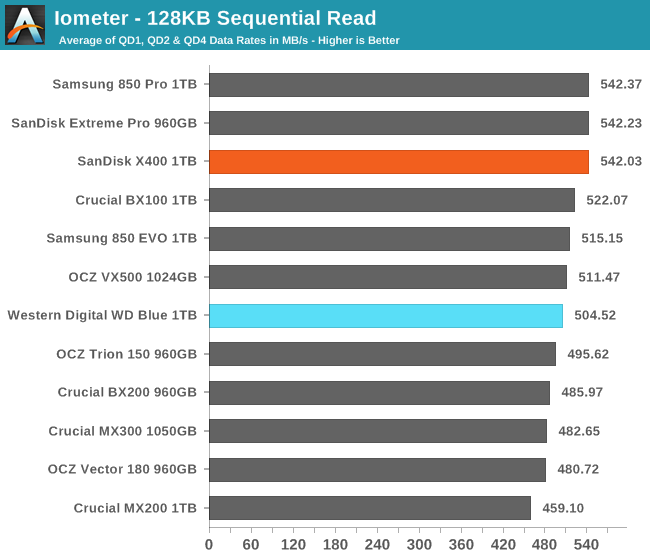
While the SanDisk X400 tied the best MLC SSDs for sequential read speed, the WD Blue is merely average overall.
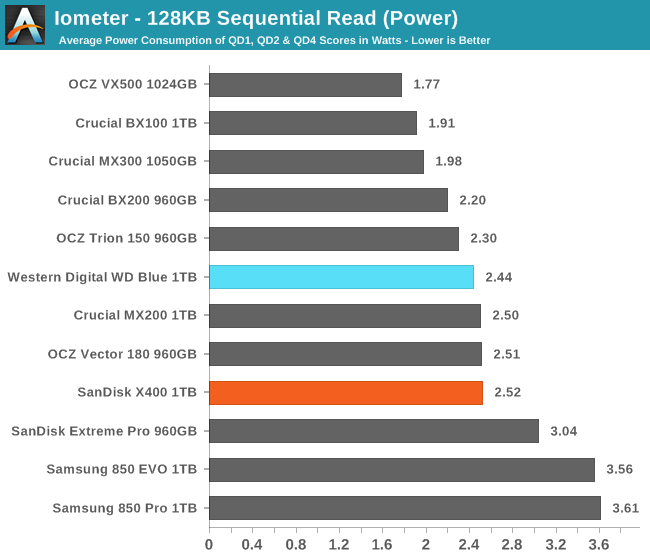
The WD Blue draws slightly less power than the X400, but given the size of the performance regression the WD Blue is actually less efficient for once.
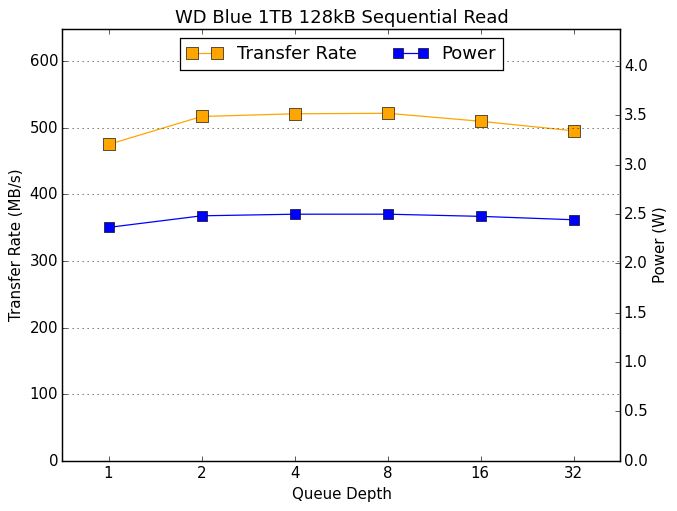 |
|||||||||
The WD Blue seems to hit a performance plateau that is a bit shy of saturating the SATA link, and then it slows down at the highest queue depths.
Sequential Write Performance
The sequential write test writes 128kB blocks and tests queue depths ranging from 1 to 32. The queue depth is doubled every three minutes, for a total test duration of 18 minutes. The test spans the entire drive, and the drive is filled before the test begins. The primary score we report is an average of performances at queue depths 1, 2 and 4, as client usage typically consists mostly of low queue depth operations.
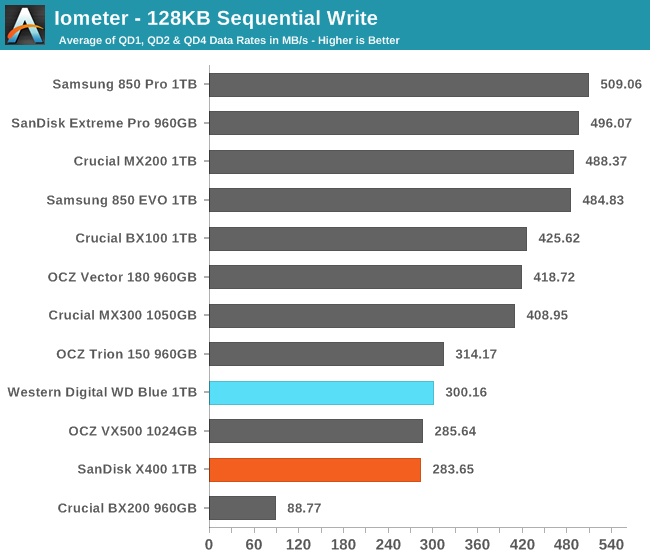
The WD Blue has a faster sequential write speed than the X400, but doesn't quite catch up to the OCZ Trion 150. Most MLC and 3D TLC drives are significantly faster than the planar TLC drives.
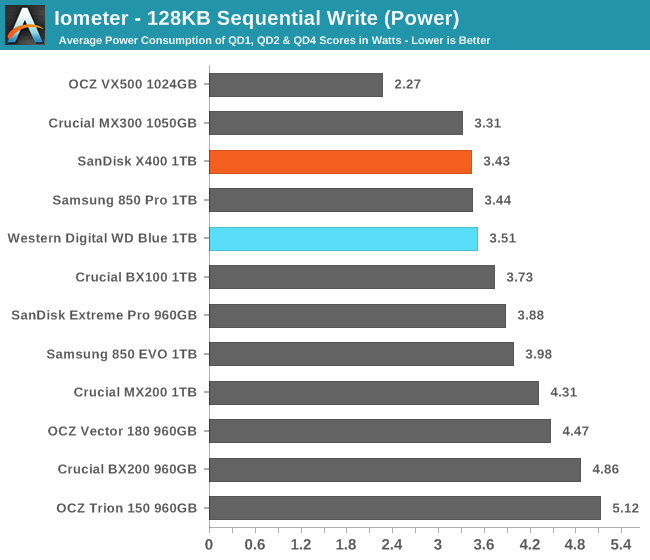
The WD Blue draws more power than the SanDisk X400 during the sequential write test, but it is justified by the improved performance. Efficiency is still only good by planar TLC standards.
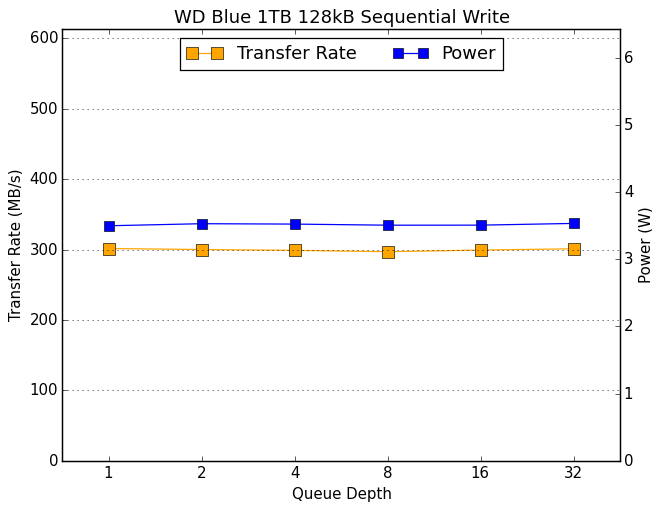 |
|||||||||
The WD Blue's sequential read speed is constant across all queue depths, without even an increase from QD1 to QD2.










75 Comments
View All Comments
Arbie - Tuesday, October 11, 2016 - link
I agree with another comment. Why is the Mushkin Reactor 1TB not in the charts for recent SSD reviews? At $230 it's cheaper than many, is MLC, and overall seems like a great buy. You reviewed it but then seem to have forgotten it.DanNeely - Tuesday, October 11, 2016 - link
I'm a bit puzzled by the performance consistency numbers here. In them the WD Blue 1TB seems to be consistently faster than the Sandisk X400 1TB before reaching steady state and about the same speed once it hits that point; but in almost all the other benches the Sandisk scores higher.Billy Tallis - Tuesday, October 11, 2016 - link
The drive is completely filled once before the random write consistency test, which runs at QD32. Most of the other IOmeter scores are averages of low queue depths, and the random write test on page 6 is limited to a 16GB test file on an otherwise empty drive. Whatever effect caused the WD Blue to have lower peak performance is more significant for the shorter test, while for the consistency test the fact that the WD Blue has more spare area to start with than the X400 is a bigger factor.kmmatney - Tuesday, October 11, 2016 - link
I bought a SanDisk Ultra II 960GB drive about a year ago for around $200, and it's still close to that price ($219 at the moment). It's the one with SLC cache - I use it in my everyday work computer, as my OS drive, and I typically run 1-2 virtual machines as well. So I push it fairly hard for a consumer SSD, and it still runs great - no complaints at all, and I'd recommend it for the price.Michael Bay - Thursday, October 13, 2016 - link
Same experience here. In a few weeks it will be a year of use for me, and if Sandisk utility is to be trusted, it`s only 1% worn.mapesdhs - Friday, October 14, 2016 - link
It's a pity the X300 is not available anymore, it had very good consistency and at one point was cheaper than many budget models.Shadowmaster625 - Tuesday, October 11, 2016 - link
It is amazing that they fit all that on one side of the board without so much as a capacitor on the back...LordConrad - Tuesday, October 11, 2016 - link
Sorry, I refuse to buy a SSD that uses TLC planar NAND.TheinsanegamerN - Tuesday, October 11, 2016 - link
why? these have higher write endurance then some MLC drives.MrCommunistGen - Tuesday, October 11, 2016 - link
That was quick - WD releasing an SSD under their own name. Sure it is a warmed over X400, but as the performance numbers indicate they didn't just slap a sticker on it... which leads to my next comment.When I read the opening of the article I was pretty excited. X400 with a bit more overprovisioning. I was expecting to see extra performance (even if only a little) along with the endurance. I guess not. Oh well.